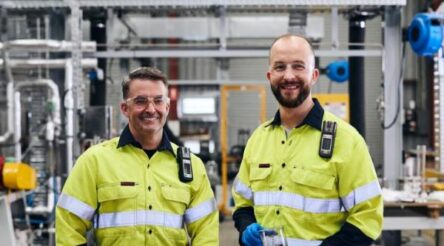Technologies and tools for a manufacturing transformation – preparing for tomorrow with digital solutions by Ben Tan

In today’s second 3D printing-related contribution to @AuManufacturing’s “technologies and tools…” series, Ben Tan looks at supply chains and workflows now and post-pandemic.
Manufacturing has gone through tremendous changes since The Industrial Revolution, where items were being produced by hand. Today, rapid technological advancements such as robotics and automation have enabled manufacturers to harness valuable data and turn them into actionable insights.
Despite the advances in technology, manufacturers were hit in an unprecedented way by the COVID-19 pandemic. The pandemic caused severe disruptions in supply chains due to closures of plants and factories worldwide. Factories that produced consumer goods could not meet surging demands and that caused panic buying worldwide. Those that have digitised, have largely emerged unscathed as they could continue their operations albeit under stringent measures, and only if they were deemed as providing essential goods services.
In an age of volatility where pandemics and technological advancements threaten to challenge the conventional way of manufacturing, what can manufacturers do to ensure they stay commercially viable beyond the crisis and sustain into Industry 4.0?
Build inwards for resilience
On a macro level, there is a need to become more self-reliant. In a bid to be more cost-efficient, many developed countries have been relying on foreign trade from developing countries (read: lower cost labour) such as China, India and Vietnam. These countries are manufacturing and export hubs for mobile phone parts and consumer electronics. Perhaps it’s timely now for countries to look inwards into building a pool of skilled workers and rebuild their domestic manufacturing as part of national sustainability plans. Even in land-scarce Singapore, the authorities recently invested a $30 million grant for local farms to ramp up production of eggs, vegetables and fish after it nearly experienced disruptions to food supplies when its neighbouring countries announced their border closures.
Create ‘Digital’ Supply Chains
There is a need to re-evaluate supply chains to minimise risk to operations and the best way to strengthen them is through digitalisation. There are vulnerabilities associated with global supply chains, and businesses should turn to 3D printing for a local on-demand manufacturing strategy to counter these gaps. For instance, instead of manufacturing an item and shipping it to a warehouse in another country, 3D printing allows for digital files to be produced on-site, on-demand. This not only circumvents the issue of border closures, delivering greater flexibility and fluidity, but drastically reduces supply chain risks, wastages and footprints.
Transform and reshape to ramp up for the future
Since the start of the pandemic, business as usual has taken on a new twist – it is now “business unusual”. Manufacturers have an urgent task ahead in transforming the way they do business, centred around digitalisation.
At a time where social distancing and employee safety measures are thrown into the mix as an additional layer of challenges, manufacturers must quickly redesign their workflows through the adoption of remote collaboration and diagnostics tools for the next phase of manufacturing. This will enable employees to work virtually in the labour-intensive sector, enabled by data insights and automation. Factories will have to go on a split team mode where half of the team are located physically onsite to keep machines running seamlessly, while the other half are connected remotely to support the onsite team.
Accommodate greater use of 3D printing
The pandemic has accelerated the pace in which manufacturers are forced to adopt technologies and integrate them into their existing workflows and infrastructure to stay afloat. One technology that has had a breakthrough moment during the crisis was 3D printing. There were many news reports on how various countries ranging from the US to Italy to Malaysia and the Philippines, have fully leveraged 3D printing to produce personal protection equipment (PPE) like face shields and medical accessories such as ventilators and ventilator tubing connectors.
3D printing technology in manufacturing is not new. It is now an essential part of progressive business solutions and processes, where IT merges with manufacturing, culminating in digital manufacturing. Manufacturing conglomerates such as Heineken, Schubert and ERIKS have long since integrated 3D printing into their workflows, automating their processes, optimising productivity and harnessing it for research and development efforts. And now it has proven that it can plug the gap where there are material shortages, and circumvent issues of border closures.
Beyond the pandemic, companies will be responding to competitive pressures, looking to reduce overheads and improve profit margins. 3D printing technology, which is an essential part of progressive business solutions and processes, is poised to transform the way companies do business.
According to Reports and Data, additive manufacturing in the Asia Pacific region is set to grow at the fastest rate of 18% from 2018-2026 due to a large untapped market and strong trajectory growth of the economies.
Policymakers have started paving the way for greater use of additive manufacturing by providing support and grants to build up capabilities and infrastructure. This spells a more conducive operating environment for manufacturers, distributors and suppliers alike to harness 3D printing technology on a greater scale.
Deep-dive and build reservoir of smart manufacturing
If the next phase of smart manufacturing is primed for 3D printing, companies must act now to equip their workforce with deep knowledge on 3D printing, as well as the ability to analyse data from automation reports and translate this into actionable insights. Through this process, manufacturers can find out where the gaps are, and improve existing and future work processes accordingly.
So much has been said about the trail of destruction caused by COVID-19. But the truth is, the digitalisation journey for manufacturing has been in the works for a while now; the pandemic only served to hasten the process. AI, automation and additive manufacturing are no longer buzzwords. They are digital solutions that manufacturers must implement immediately to transform. Every business must imagine what the new future norm will be, and invest now to prepare for tomorrow.
Benjamin Tan is Vice President, Ultimaker Asia Pacific.
 @AuManufacturing’s Technologies and tools for a manufacturing transformation series is brought to you with
@AuManufacturing’s Technologies and tools for a manufacturing transformation series is brought to you with

the support of Titomic and the Advanced Manufacturing Growth Centre.
Subscribe to our free @AuManufacturing newsletter here.
Topics Manufacturing News Technology
@aumanufacturing Sections
Analysis and Commentary Awards Defence Manufacturing News Podcast Technology Videos










